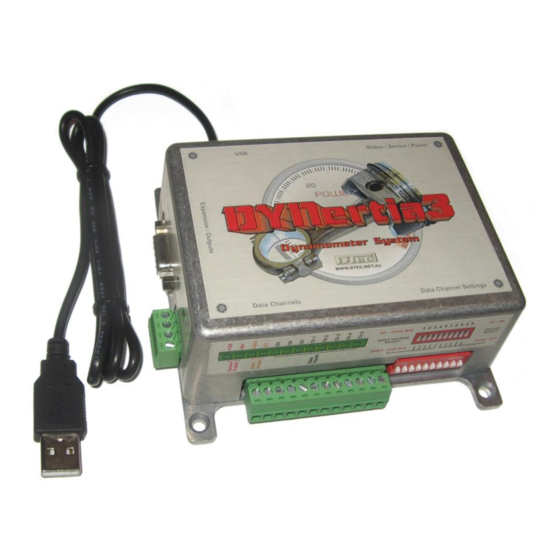- ページ 12
計測機器 dtec DYNertia3のPDF クイック・スタート・マニュアルをオンラインで閲覧またはダウンロードできます。dtec DYNertia3 20 ページ。

DYNertia3 Quick Start (Inertia- Chassis type)
.
Performing a Basic Inertia Test 'Run'
All dyno run setup is done in this main 'DYNO' Window:
It is important to set 'Record Settings' 'Run Minimum & Maximum' to a suitable start and
finish RPM for the test. Set the maximum run RPM to just below the RPM you wish to test
to, set the minimum RPM to just above the RPM you start testing at.
Check that 'Current Ratio' is set to "Ratio 4", assuming this is the button we used
previously to 'teach' a ratio in this example.
You are now ready to perform a test!
Ride the bike in the test gear (4
'Run Minimum'.
Press 'Start Run' button.
Snap open the throttle (when the 'Minimum Speed' is exceeded recording begins). When the
maximum RPM you wish to test to is reached shut off throttle and pull in the clutch simultaneously.
Press 'Stop Run' button again to end recording.
After the test finishes you will be
presented with a test run summary
and you can decide now if you wish
to save the run.
Tip-
You can click on the graph in
the summary to see the data
highlighted in the table.
Enter a descriptive run file name for easy future reference. The default folder used is called 'Samples'!
If you have the optional 'Weather Watch' hardware all this data is
updated automatically, but first you must select the menu option
"Setup/Communications", connect the unit and 'Link' the Weather
Watch hardware.
th
in this example), hold the speed below what you have set for a
www.dtec.net.au
Enter the current Temperature,
Barometric pressure and Humidity into the
'Correction Factors' box. If you have no
weather data then go to menu option
"Setup/Software" and select "No
correction" in "DYNO Correction Systems".
12
